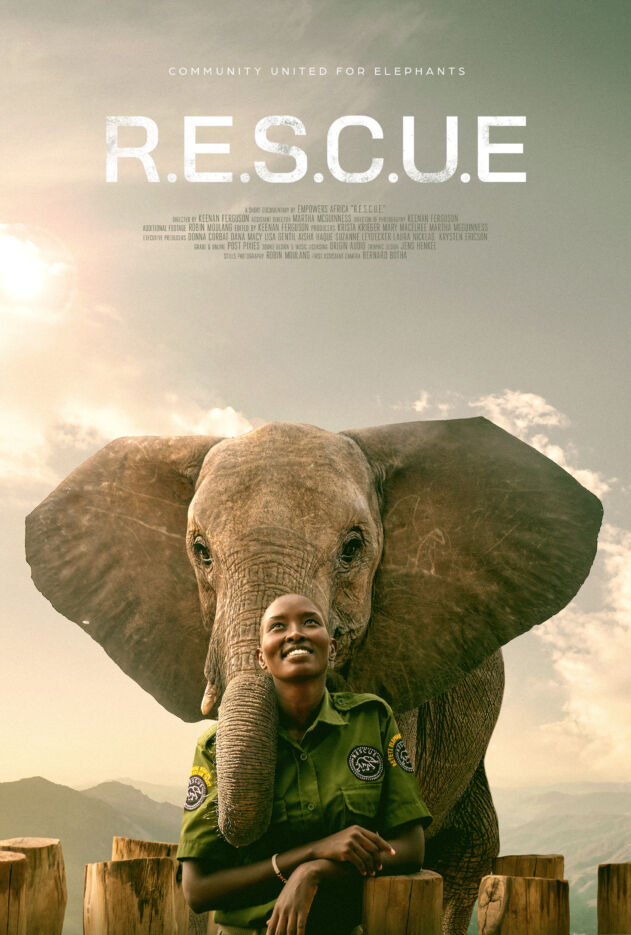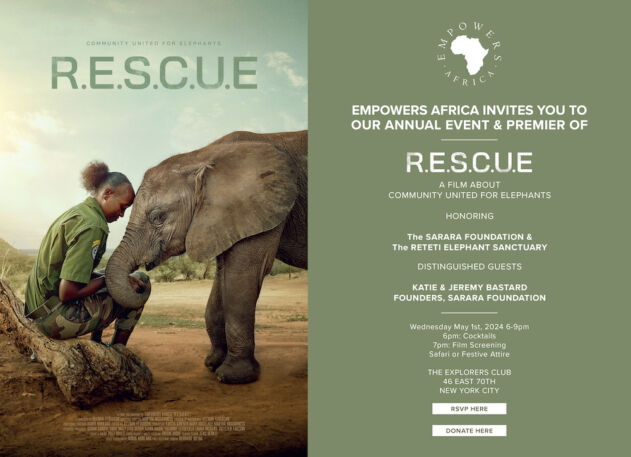All About Elephants and Empowers Africa’s Latest Documentary R.E.S.C.U.E Featuring the Reteti Elephant Sanctuary

Empowers Africa is working to create a brighter future for Africa, its people, and its animals. We partner with some of the leaders in African elephant conservation. That’s especially true for the Reteti Elephant Sanctuary, one of Africa’s most successful elephant rescue and conservation organizations working tirelessly to save elephants and empower local communities.
R.E.S.C.U.E., Empowers Africa’s documentary about Reteti Elephant Sanctuary, will premiere at their Annual Event on May 1st at The Explorers Club in New York City. As you watch the film, immerse yourself in captivating stories of resilience, hope, and triumph in the fight to protect a species and empower communities.
Be prepared to be moved, inspired, and empowered as we celebrate the remarkable achievements of communities united for elephants.
How to Save the Elephants with Reteti
Reteti Elephant Sanctuary, in Northern Kenya, is the first indigenously owned elephant sanctuary in Africa. It is also the first elephant sanctuary to employ female Elephant Keepers. Owned by the Samburu people, its mission is to rescue, rehabilitate, and rewild elephant orphans.When elephants arrive at Reteti, they are often malnourished and dehydrated and have sometimes endured predator attacks. Once the babies are out of intensive care and stabilized, the meticulous process of rehabilitation and care begins.
Reteti’s Elephant Keepers work around the clock to care for the babies. The orphans eat every 3 hours throughout the day and night, and the Keepers work 12-hour shifts to maintain this schedule. The keepers arrive in the kitchen 1 hour before feeding to ensure everything is adequately prepared, load the bottles, and bring them to the feeding pens.
The elephants are divided into three groups: the nursery herd (under two years), the teenage herd, and the graduate herd. Each elephant requires a different formula based on its nutritional needs and development stage. Bottles are marked in enormous letters to prevent mix-ups. Watching the babies charge in to eat, ears flapping in the wind, is absolutely joyous. They tromp and trumpet looking for the keeper who is singing their name. Then, almost in unison, a chorus of slurping begins.
Elephant Rescue and Conservation Programs
Reteti Elephant Sanctuary was created by the Sarara Foundation, an organization dedicated to helping the Samburu people maintain their cultural heritage and traditions while enabling them to thrive economically in a modernizing world.
What makes the Sarara Foundation different from other conservation-minded NGOs is that the initiatives are solely owned by the local people and the income generated goes directly back to the people. Reteti, owned and run by the Samburu, is a foremost example of this strategy. All the elephant keepers at Reteti come from the local community.
One thing that’s been key to Reteti Elephant Sanctuary’s success is the local community’s role, particularly the Samburu women. There is no better example of this success than Reteti’s Milk to Market program. The Elephant Sanctuary worked with Samburu women to develop a formula for the baby elephants using excess milk from Samburu goats.
The result is a sustainable food source for the elephant sanctuary and a new livelihood for Samburu women. Dorothy brought our crew to a local Samburu manyatta where we met the women and children as they milked their goats. We accompanied them on their walk to sell the milk and heard from the women how the program has affected their lives. Today, more than 800 Samburu women sell goat milk to the Sarara Foundation and have their own means to provide food, healthcare, and education for their families.

Elephant Documentary Premiere: R.E.S.C.U.E – A Film About Community United for Elephants
We are delighted to announce the release of R.E.S.C.U.E, a heartwarming short documentary about resilience, hope, and triumph in the fight to protect a species and to empower communities. Empowers Africa Trustee Martha McGuinness co-directed and co-produced the documentary and spent several weeks on the ground in Kenya.
The film brings viewers inside Reteti through the eyes of Dorothy Lowaktuk, a female elephant keeper from a local Samburu village. Dorothy was one of the first elephant keepers at Reteti and the first female elephant keepers in East Africa. She is dedicated and passionate about conservation and her work as an Elephant Keeper. She takes us through life at the sanctuary so that we understand exactly what is involved in rescuing, rehabilitating, and eventually releasing the elephants back into the wild.
Don’t miss out: secure your spot and participate in this extraordinary evening.
Wednesday, May 1st, 2024
6 – 9 pm
The Explorers Club, 46th East 70th, New York City
What is Elephant Poaching
Poaching is the act of killing an animal illegally, often endangered or threatened animals with valuable furs or tusks. Elephant poaching is often a result of the ivory trade, as their tusks are precious on the illegal international black market for ivory.
Not only does elephant poaching threaten a species, but it fosters crime and upends the natural biosphere which can lead to crop failure, poverty, and significant climate fallout. Elephant poaching is typically driven by international crime syndicates and powered by the strong ivory trade in Asia.
Elephant Poaching Statistics
Elephant poaching is so common that many elephant poaching statistics are staggering. According to the World Wildlife Fund, poachers kill about 20,000 elephants every single year for their tusks.
Elephant Poaching in Africa
Though powered by the ivory trade in Thailand, most of the killing happens on the plains of Africa. According to National Geographic, Both endangered savanna and critically endangered forest elephants are declining from the direct impact of elephant poaching in Africa. “Combined numbers have fallen to about 415,000 according to the Internal Union for Conservation of Nature.”
Often, poachers can be successful in Africa because of the large expanse of land that elephants call home. African preserves, the habitat of many elephants, are vast, making it difficult and expensive to oversee elephant herds.
Interesting Facts about Elephants
Did you know male elephants stay with their mothers for up to 16 years before leaving alone? At the Reteti Elephant Sanctuary, the elephant keepers stress that no orphan elephant is ready for release before seven years of age. Moreover, they must be released as a herd with an established matriarch to survive. Reteti plans to release a record 13 elephants back into the wild this spring.
Before Reteti can return an elephant to the wild, the elephant must be completely weaned off their bottles. The formula is gradually diluted with water, which decreases the nutrients and causes the elephants to source food on their own instinctively.
To teach and prepare the elephant orphans to be independent, Reteti’s Elephant Keepers lead the orphan elephants on walks in the wild four times a day. During these walks the elephants will learn about their natural environment, how to find food and water, and how to interact with wild herds and predators. The keepers must balance teaching the elephants while not thwarting development toward independence. It is a lengthy and carefully monitored process.

Elephant Documentaries to Watch and Feel Inspired
Nothing helps to capture the stories of elephant conservation better than a powerful documentary. They often inspire viewers to action, contributing money, time, and attention to organizations fighting for elephant rescue and conservation throughout Africa and beyond.
Six Elephant Documentaries to Watch This Weekend
1. Secrets of the Elephants, 2023
Elephants are powerful, loving, and wise, but we are only starting to unlock their deepest secrets. The ground-breaking, award-winning natural history franchise SECRETS OF returns with its next installment, SECRETS OF THE ELEPHANTS. The series travels the world — from the Savannahs of Africa to the urban landscapes of Asia — to discover the strategic thinking, complex emotions, and sophisticated language of elephants, shaping a unique and dynamic culture. Featuring renowned National Geographic Explorer and elephant expert Dr. Paula Kahumbu, the four-part series not only reveals the extraordinary lives of different families of elephants but also highlights how similar they are to us. SECRETS OF THE ELEPHANTS will change everything you thought you knew about elephants forever. –– National Geographic website
2. Love & Bananas, 2018
“Elephant rescues in Thailand are rare, unpredictable and often life-threatening. After waiting 2.5 years, actor/director Ashley Bell and a team of elephant rescuers led by world-renowned Asian elephant conservationist and TIME Magazine’s Hero of Asia, Lek Chailert, embark on a daring mission 480 miles across Thailand to rescue Noi Na, a 70-year old partially blind trekking elephant and bring her to freedom.” –– Love & Bananas website
3. The Elephant Queen, 2018
“The Elephant Queen’s enduring themes are built upon a foundation of authenticity and integrity, brought from filmmakers Mark Deeble and Victoria Stone’s 60 years of collective experience in the rich tradition of wildlife documentary filmmaking and production. Deeble and Stone, who are Emmy and Peabody Award winners, spent 25 years living in the East African bush, preparing them for the unforgettable odyssey of The Elephant Queen.” –– The Elephant Queen website
4. The Elephant Whisperers, 2022
“Bomman and Bellie, a couple in south India, devote their lives to caring for an orphaned baby elephant named Raghu, forging a family like no other.” ––The Elephant Whisperers, available on Netflix
5. The Elephant and the Termite, 2021
“Witness the creation of the waterhole, one of Africa’s greatest wildlife meeting places manufactured by giant elephants and tiny termites. From baboons to dung beetles to chameleons, an entire community of creatures call the waterhole their home.” ––The Elephant and the Termite, on PBS
6. When Elephants Were Young, 2016
When Elephants Were Young tells the story of a young man and his elephant who live and street-beg in Bangkok. It portrays the conservation issues that threaten the elephant’s survival until the opportunity comes to release the elephant into the wild. The elephant successfully rehabilitates to the wild, joining a family of wild elephants. The story demonstrates a positive conservation model for the future survival of endangered Asian elephants. William Shatner narrates the film.” ––When Elephants Were Young website